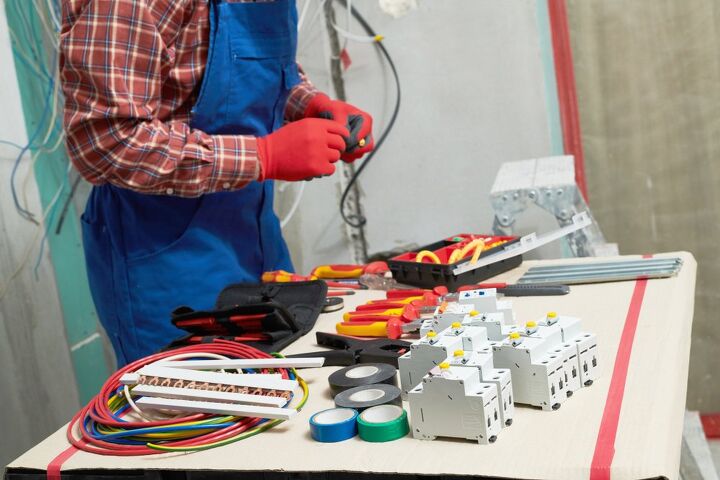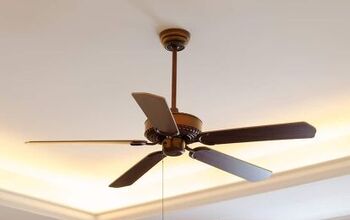How To Crimp A Cable Ferrule Without A Swagging Tool

Commonly found throughout your home to support heavy weights like garage doors, wire cables are known for their durability and strength. By looping a cable onto itself in a process called swagging, it is possible to increase the break strength of the cable even more. To create a cable swag, you must use a fastening device called a cable ferrule with a unique tool known as a swagging tool.
If you do not have a swagging tool available to crimp a cable ferrule in place, it is still possible to use a cable ferrule. Instead of using a specialized swagging tool, you can use a standard pair of pliers, a vise, or a hammer. These methods will crimp the ferrule in place, allowing you to splice cable together in a supportive and robust loop.
Of course, before attempting to increase the break strength of any cable, it is best to test your loop before loading your line up with weight. Do not rely on your cable assembly to hold hefty weights that drastically exceed the cable’s break strength if you use improvised crimping techniques.
Do You Need Electricial Wiring or Panel Upgrade Services?
Get free, zero-commitment quotes from pro contractors near you.

What is a Cable Ferrule?
Generally speaking, a ferrule is any device that can help to hold multiple pieces or segments together. A cable ferrule is used to help keep pieces of metal cable together. The ferrule itself appears as a metal jacket, similar to a metal cylinder. This fastener can be a single cylinder, used to splice pieces of cable together, or it can be a double ferrule, with cylinders side by side to allow the user to create a loop.
A cable ferrule can come in many sizes to help accommodate the size of individual wires you are binding. Before choosing your metal ferrule, be sure that the wire cable can easily pass through the openings.
Importance of a Cable Ferrule
Compared to other materials and methods used to bind wire together, a cable ferrule provides a simple, effective, and relatively quick way to secure the cable. Usually, cable is made of individual metal wires that are woven together to create a strong and durable material. A cable can be difficult to work with and often is not flexible.
Using a ferrule is the perfect way to bind cables together safely and securely. A ferrule works to crimp the individual wires together in one secure location. Having multiple wires crimped together and secured will give one point of contact, making the splice, loop, or attachment safe and secure, increasing the strength of the assembly.
Cable Ferrule Alternatives
When you don’t have the proper swagging tool and do not have the right alternative tool options, it can leave homeowners stuck. Luckily, there are plenty of alternative fasteners that can work as a ferrule does, allowing you to create a loop in cable. One of the best alternative options is called a wire rope clip. This device allows the metal cable to pass through the clip, effectively stacking the cable’s two sides on top of one another.
At the underside of the fastener, there are two screws. These screws will cause the wire rope clip to clamp down even tighter against the cable’s two sides, creating the same loop or swag as a cable ferrule would. This process allows you to have the same effect as a ferrule by only using a standard screwdriver to tighten the screws.
Multiple wire rope clips should be used together, spaced out to provide strength and flexibility. While a wire rope clip can give you the same power and integrity as a cable ferrule, it is often a more complicated and lengthy process. Plus, wire rope clips are more costly than a cable ferrule.
How a Cable Ferrule to Increasing Strength
Cable is an incredibly strong material that is used in several residential and industrial applications. The cable is made of several individual metal wires twisted together into a tight strand. Sometimes though, it is necessary to increase the strength of your cable even more. You may have to strengthen your existing cable to support a heavyweight or withstand a great deal of tension on the cable.
One of the best ways to increase your cable’s strength is to create additional loops within the structure, called swagging, allowing the metal cable to loop back on itself. Swagging can allow the cable to greatly exceed the rated break strength, allowing you to add more load to your structure. To safely loop cable, the best method is to use a fastener called a cable ferrule.
To properly increase the strength of your cable, you must install your ferrule correctly. To do this, you will need a metal cable ferrule as well as a metal stop.
- First, put the metal stop at the end of the cable or loop and crimp it into place.
- Next, create the loop of the desired length.
- Remember that side-by-side applications of cable with a ferrule often require more material than a simple loop at the top.
- Be sure to cut the additional cable to accommodate the necessary stop at the end.
If you are applying multiple ferrules to your assembly, be sure to leave the required amount of space between the ferrules. This gap will allow your cable assembly to have the right combination of strength and flexibility. Be sure to leave plenty of space between the last ferrule and the stop at the end.
Of course, before using your cable assembly entirely, test the loop you have just created ahead of time to ensure it will withstand the additional weight and strain.
How To Crimp A Cable Ferrule Without A Swagging Tool
To properly crimp cable together in a ferrule, you will use what is called a swagging tool. This device is a specialty tool that works to crimp the ferrule metal together easily and securely. Unfortunately, not everyone has this specialized tool in their home. But, using some ingenuity, it is possible to still crimp a cable ferrule even without the right tool.
- Pliers: Depending on the cable’s thickness and the thickness of the ferrule, you may be able to use a standard pair of pliers to help crimp the assembly. Position the ferrule in the correct location. Once set, apply as much pressure as possible to crimp the metal fastener into place. You should see the metal ferrule start to bend and conform around the metal cables.
- Vise: This tool will give you additional leverage to help get a tight seal around your cable. With the ferrule in place, position the cable in the vise and gradually apply pressure. Be sure not to over-tighten the ferrule, which can cause damage to the metal casing, jeopardizing the integrity of the connection.
- Hammer: You can apply direct impact to the ferrule itself, causing it to crimp around the metal. Alternatively, you can use a hammer and nail method. Using a thin nail, perforate the ferrule casing in a zig-zag pattern with the cable inserted in the ferrule. This pattern will create tension at certain points along the cable, making it harder for the cable to slip out.
Remember that you can never fully trust the ferrule’s integrity and the cable’s strength using an alternative crimping method. The only way to truly trust that your cable splice or loop is secured is with an actual swagging tool intended to perform the work. Before using your new cable assembly, always test the loop and structure with a test weight before using it for your final weight load.
Do You Need Electricial Wiring or Panel Upgrade Services?
Get free, zero-commitment quotes from pro contractors near you.

Related Questions
What tools do I need to work with cable or wire?
To work with wire cable, you will require a few common tools that many homeowners have. While you may have a swagging tool to crimp a cable ferrule properly, you may require the use of a vise, hammer, or pliers if you do not. Further, to work with the cable itself, you will need a tape measurer and hacksaw. Cable material is thick and strong, so a saw is required to cut through thick cable sections.For thin cable sections, you may be able to use wire cutters to cut the desired length. Remember, once you cut the cable and install the ferrule, it creates a permanent assembly, so be sure to measure twice and cut once.
What comes in a ferrule kit?
To help homeowners work with cable in their homes, many manufacturers will offer a ferrule kit. This kit is a convenient way to get all the parts and tools necessary to complete your job.A ferrule kit will usually include multiple sizes of metal ferrule fasteners to accommodate different cable thicknesses. A ferrule kit will also include the necessary swagging tool to ensure a tight and secure connection. Some deluxe ferrule kits will even include wire rope clips giving homeowners options and choices to crimp and swag their cable correctly.
Related Guides

We are a team of passionate homeowners, home improvement pros, and DIY enthusiasts who enjoy sharing home improvement, housekeeping, decorating, and more with other homeowners! Whether you're looking for a step-by-step guide on fixing an appliance or the cost of installing a fence, we've here to help.
More by Upgraded Home Team













![10 Best Cordless Leaf Blowers – [2022 Reviews & Ultimate Guide]](https://cdn-fastly.upgradedhome.com/media/2023/07/31/9070789/10-best-cordless-leaf-blowers-2022-reviews-ultimate-guide.jpg?size=350x220)













